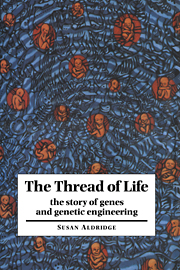7 - Genes – the human angle
from PART II - Engineering genes
Published online by Cambridge University Press: 16 March 2010
Summary
Molecular biology and the DNA revolution are already having an enormous impact on medicine. There is an increasing emphasis on the role of genes in disease, along with powerful new DNA technologies for exploring an individual's genome. At the same time, the molecular approach has given important insights into some of the toughest problems in biology: development, ageing and cancer. We even have the tools to change our genes or control their activity, using gene therapy.
The basics of human genetics and the different DNA testing methods are looked at in this chapter. The new medical research findings that have emerged from molecular biology, along with the prospect of DNA-based therapies, are reviewed in Chapter 8.
Human genetics – a basic guide
The DNA molecule at the heart of each cell in the human body is like a signature, unique to each individual. There is only one exception to this rule. Identical – or monozygotic – twins have identical genomes. The reason is that they develop from a single fertilised egg that splits into two embryos sometime during the first two weeks of a pregnancy. As we shall see, research on twins is important in trying to assess the relative contributions of genes and the environment to someone's physical and mental make-up.
Within the three billion base pair sequence of the human DNA molecule there is obviously plenty of scope for variation in the ordering of the four bases. At the same time, all human DNA molecules have a broad similarity, which lets us all function as members of the same species.
- Type
- Chapter
- Information
- The Thread of LifeThe Story of Genes and Genetic Engineering, pp. 137 - 164Publisher: Cambridge University PressPrint publication year: 1996



